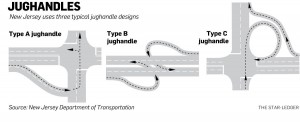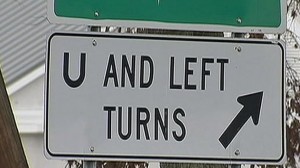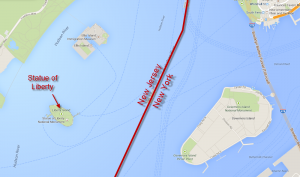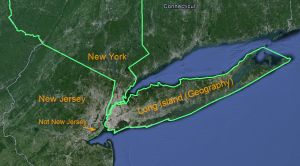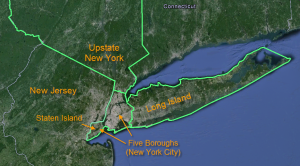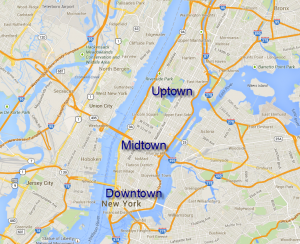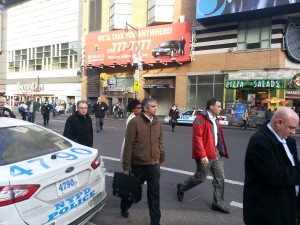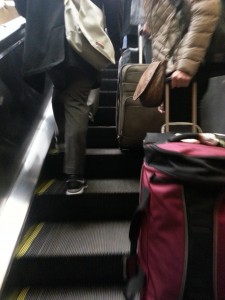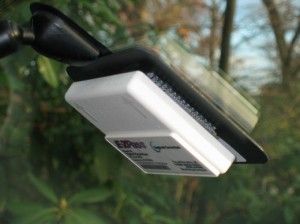Archive for category Community
24 Things Every Midwesterner and Westcoaster Should Know about New Jersey and New York
Welcome to New Jersey and New York. As west coast and Midwest import, I would like to share some of the more pronounced regional differences I’ve learned that will help you understand, appreciate, and love the great land of New Jersey and the 3 1/2 States of New York.
- Unprotected Left-Hand Turns Have the Right-of-Way
- Jughandles
- The Only Rule of the Road: Efficiency
- Public Transportation: It Actually Works
- Real New Yorkers Don’t Have a License
- New Jerseyans Don’t Pump Gas
- Your Town is the Center of the Universe
- Being “From Here”
- No, Really, New Jersey is Beautiful!
- The Statue of Liberty is Actually in New Jersey—Sort of
- There are 3 1/2 States of New York
- “Uptown,” “Midtown,” and “Downtown” are Three Different Places
- It’s the “Shore,” not the “Beach”
- Foodie Heaven
- Conversation is a Sport; Like Jousting
- Treat Sidewalks like Offensive Football
- Jaywalking
- Stand Right, Walk Left
- Role of Government
- Roadside Donations
- Gun Culture
- Tolls
- Parking
- Homes and Other Stuff
Driving and Public Transportation
1. Unprotected Left-Hand Turns Have the Right-of-Way
Every state has its driving quirks. California has “rolling stops,” and Utah has “rolling barricades.” New Jersey has a few driving quirks of its own.
If you are the first car at a stoplight making an unprotected left-hand turn, you have the right of way… at least by custom. Oncoming traffic will wait for you, and if you don’t take the free left, you’re likely to get a honk from the person behind you.
Taking the left turn (quickly, and without hesitation) is considered good driving etiquette because it does not delay oncoming traffic, and speeds the motorists behind you who want to go straight through the intersection. Don’t hesitate—hesitation and trepidation will only confuse other motorists, create a hazard, and earn you glares and honks.
Disclaimer: Either do this right or don’t do it at all. Although I’ve seen cops yield the right-of-way to unprotected left hand turns, I’m pretty sure it isn’t technically legal. If you get T-boned in New Jersey, “I read on a blog post that I had the right of way” is not a valid defense.
2. Jughandles
New Jersey uses a strange, but efficient intersection configuration called a “jughandle.” Some intersections require you to exit to the right in order to make a left- or U-turn. After you exit to the right, a short strip of road will swing you out to the right, then turn in and intersect the main road at a 90 degree angle. You finish your left-hand turn by going straight through the intersection, or complete the U-turn by turning left.
From above, they can look a little like jug handles.
They’re not so bad once you get used to them. But annoyingly, the jughandle is not uniformly implemented, even on a single stretch of road; so be prepared to make a last-second dart to the right or left to make a left-hand or U-turn. Road signs that say “U Turn,” and point to the right indicate a jughandle.
3. The Only Rule of the Road: Efficiency
Just remember one thing when driving in New Jersey and New York: Efficiency. Whatever you do, be decisive. Imagine every one of your fellow motorists reminding you in a thick New Jersey or New York accent, “Don’t try to be nice, don’t hesitate and don’t slow down. Just do what I think you’re going to do, and we won’t have problems, got it?” A decisive, efficient jerk is safer and tolerated far more than a “thoughtful,” hesitant, or indecisive driver.
In traffic circles, choose the direction you want to go, and just go for it. Others will yield unless they smell fear or indecision. When merging, six inches of clearance is plenty of room. Blink once and merge. If you blink twice, you lose your chance.
I realized how much I have transformed to an efficient east-coast driver when I visited family in Utah. I found myself driving very efficiently, and in the process, cutting off old ladies and probably raising the blood pressure of my fellow motorists. In Utah, that kind of efficiency is inconsiderate. In New Jersey, it’s conscientious because you’re saving yourself and others time.
4. Public Transportation: It Actually Works
Unlike most places in the country, Northern New Jersey and New York have great public transportation. New York’s public transportation is so ubiquitous that most people don’t have a driver’s license (see #5). Taking public transportation is the social norm, and is cheaper than paying tolls and parking (see #22 and #23). Personally, I love the bus and train; my morning and evening commutes are far less stressful than when I have to drive, and I can spend the time writing articles like this.
5. Real New Yorkers Don’t Have a License
In many parts of the United States, getting a driver’s license is a coming-of-age rite of passage. I had my license more or less on my 16th birthday. But in New York City, a driver’s license is irrelevant to most people.
To illustrate, I work in Manhattan. Of my four New York City co-workers, two have never had a license, one let it expire (his exact words were, “I think it expired a year-and-a-half ago,” as if he was talking about an expired library card), and one hardly ever uses his. Licenses are just not relevant. They take the bus, train, subway or cab everywhere. See #4.
6. New Jerseyans Don’t Pump Gas
New Jersey is one of two states in the US that does not allow its citizens to pump their own gas. That’s right… you’re not allowed to pump your own gas. While the official reason for this idiosyncrasy has something to do with protecting the environment, everybody knows that it’s really about jobs.
Important: It is not expected nor customary to tip the person who pumps your gas.
Geography
7. Your Town is the Center of the Universe
Your local community is the center of the universe; remember that, and you’ll integrate fine. I commute to Midtown Manhattan from Northern New Jersey each morning. Having moved most recently from a Maryland suburb of Washington DC, I thought my most recent move was to a New Jersey suburb of Manhattan.
Boy, was I wrong! I quickly found out that Nutley, NJ is most certainly NOT a suburb of Manhattan. A proud town with a distinguished history of its own right, it is more correct to think of Manhattan as a suburb of Nutley, NJ… that is, if you ask anyone from Nutley.
The same could be said for any community in New Jersey or New York. I love the self-contained, community-centric personality of New Jersey and New York communities. In New Jersey, every town has its own school district, stores, mechanics, and miniature financial ecosystem. And anything you could want is no more than a 20-minute drive away.
8. Being “From Here”
Being “From Here” in New Jersey and New York means something very different than in DC, Salt Lake, or California. To illustrate, I can almost literally throw a stone into the adjoining town, Clifton, from my house in Nutley, NJ. I remember once asking a neighbor, “Are you from here?” To which he replied, “Oh, no, no no… I’m not from here. I’m from Clifton.” I encountered similar puzzling responses from people in all areas of New Jersey and New York.
After careful observation, I have determined that if you can drive to your childhood home within 3 minutes, you’re “from here.” Otherwise, you’re from somewhere else.
In general, you are “from” the place you were born and went to high school. If you were born in a different place than you went to high school, then you’re from the place you were born, but you don’t have the same community credentials as someone who was born and raised in that place.
And incidentally, nobody’s from “New York City.” They’re from Queens, or the Bronx, Ryker’s Park, or some other local community (See #11).
9. No, Really, New Jersey is Beautiful!
Before moving to New Jersey, I always thought “The Garden State” was a cluelessly ironic tourist slogan. Poor New Jersey gets picked on for being ugly all the time.
But every New Jersean I know says the same thing, “No really, New Jersey is beautiful!” And now that I live here, I find myself making exactly the same defense. Don’t get me wrong, the I-95 corridor/ NJ Turnpike is, in fact, ugly. But go 10 miles inland, beyond the Meadowlands (what former generations called “swamps”), and you’ll find some of the most picturesque farms, green rolling hills, and postage-stamp towns (my favorite, of course, being Titusville, NJ). New Jersey really is beautiful. No, really… it is!
10. The Statue of Liberty is Actually in New Jersey—Sort of
Take a careful look at the Statue of Liberty in Google Maps, and you’ll notice something peculiar. It’s located inside New Jersey. Yeah, that’s right. The Statue of Liberty is in New Jersey.
At least, that’s what New Jersey thought. New York disagreed, so Congress and the Supreme Court had to step in to settle the matter. Essentially, the Statue of Liberty now sits on a little piece of New York State that sits entirely inside New Jersey. But just because the Supreme Court made a decision doesn’t mean every New Jersean is convinced.
New Jerseans also like to point out that the New York Jets and Giants play in New Jersey, and Super Bowl XLVIII was in New Jersey, among other facts.
11. There are 3 1/2 States of New York
Let’s start with a Google Earth view of the New York/New Jersey area, to the right (click to enlarge). You’ll see New York (to the North) and the large chunk of land completely surrounded by water, called “Long Island” by geographers. And although you might assume that everything to the west is New Jersey, it’s not. The section marked “Not New Jersey” is Staten Island, and even though its geography appears to be connected with New Jersey, it is most certainly NOT part of New Jersey.
Now that we’ve identified land masses, it’s time to talk about the real New York, or rather, the 3 1/2 States of New York:
- 1. The State of Upstate New York
- 2. The State of The Five Boroughs (A.K.A. “New York City”)
- 3. The State of Long Island (As differentiated from the geographic feature with the same name)
- 3 1/2. The half-State of Staten Island (Technically one of the Five Boroughs)
Upstate New York is, in the mind of most people in the Boroughs, a pretty, but mostly irrelevant land mass to the north. Upstate and the other New Yorks don’t have much in common, and they don’t talk to one another too much. Occasionally they’re forced to interact when people in Albany (the state capitol of the State of Upstate New York) try to interfere with policies of The State of New York City.
To add some nuance: The people of Upstate New York use the phrase “Downstate New York” to describe everything within about 85 miles of New York City, including Putnam, Dutchess, and Orange Counties. But nobody in the Boroughs or Long Island consider themselves “Downstate.” Many have never heard the term, or would find it insulting. In contrast, the people of New York City and south refer to everything north of Westchester as “Upstate.” As a result, poor Putnam, Dutchess, and Orange counties feel disowned by both Upstate New York, and New York City.
The Five Boroughs include Manhattan, Brooklyn, the Bronx, Queens, and Staten Island. Together, they comprise “New York City,” although almost nobody from the five Boroughs refers to “New York City.” Most people refer to the Borough they’re from, and only use “New York City” when talking to out-of-staters. Tourists who lack an appreciation for New York’s size often think of Manhattan (or more particularly Times Square) as “New York City,” but this is a misperception. Two of the Burroughs, Brooklyn and Queens, are technically located on what geography majors would call “Long Island,” but I assure you, the Five Boroughs are most certainly NOT on the real Long Island.
To add some nuance: Due to its convenient location, many Brooklynites and other natives of the Boroughs have moved to Hudson County, New Jersey, just across the River. Consequently, some in New York City refer to Hudson County as “The Sixth Borough,” but not too loudly while they’re actually in New Jersey. Such a suggestion would deeply offend New Jersey’s sense of sovereignty and identity (See #10).
Long Island begins where Queens ends, and not an inch before. It has a distinct identity, culture, and needs from the other 2 1/2 New York States, and due to its relative remoteness, Long Island behaves like a separate state in most practical respects.
Staten Island. I’ll be the first to admit that I do not understand Staten Island’s complicated relationship with the other four boroughs, but I’d have to designate Staten Island as another half-state: It is separate from New York City; it has nothing to do with Long Island; less to do with Upstate New York; and has absolutely nothing in common with New Jersey except I-278.
And it’s worth mentioning that the Hudson River might as well be an ocean, because the land masses on either sides are completely different countries.
11. “Uptown,” “Midtown,” and “Downtown” are Three Different Places
Many cities in the West and Midwest refer to their city center as “downtown.” When someone says, “I’m going downtown,” it’s more or less synonymous with “I’m going into the city.”
But not so in Manhattan. Within a several-hundred-mile radius of Manhattan, “Downtown,” “Midtown,” and “Uptown” refer to very particular sections of Manhattan. The best I can tell, Downtown goes from the southern tip of Manhattan to somewhere between 14th and 30th street, and includes the financial district. Midtown stretches from there to about 59th street, and includes Times Square and the southern edge of Central Park. And Uptown extends from there, north.
To illustrate, the following conversation would confuse anyone in this area: “I’m going downtown,” you say. “Oh, where to?” asks a native. “57th Street,” you reply. The native gives you a puzzled look because 57th Street is Midtown, not Downtown.
It is permissible to use “Downtown” when referring to another city, but you must indicate the city, e.g. “I’m going to downtown Newark.” But if you say, “I’m going Downtown,” it means you’re going to Manhattan, south of about 30th street. And there is no such thing as “Midtown” or “Uptown” in any other city. Those two places belong exclusively to Manhattan.
13. It’s the “Shore,” not the “Beach”
In New Jersey, never refer to the “beach.” All of the sunny places with sand and ocean are called the “shore.”
Same goes for New York…unless you’re going to The Hamptons. Then it’s not the beach, or the shore… it’s called “going to The Hamptons.”
Friendliness and Interacting with Others
14. Foodie Heaven
New York and New Jersey are Foodie Heaven. You could eat at a new restaurant every meal for years and never scratch the surface of good eateries. Unfortunately, I’m not a foodie.
15. Conversation is a Sport; Like Jousting
Every town and borough has a unique personality, but to Westerners and Midwesterners, people from all over this area seem somewhat abrasive and unfriendly. I assure you that people actually are quite friendly and open.
When you encounter someone who seems abrasive, just remember that they’re trying to be direct and efficient, and will appreciate the same in return. Think of conversation as a competitive sport—like jousting—where everyone is a good sport and each respects a worthy opponent. Once you understand that, you’ll grow to appreciate that directness is a form of friendliness.
16. Treat Sidewalks like Offensive Football
If you ever take a trip to Manhattan, you will find the sidewalks packed with people. If you find yourself bumping into people, use this one simple trick: Avoid looking at people, and instead look directly where you want to go. Pretend like you’re a halfback: Find your hole, then head directly for it. Looking the direction you are going will cue oncoming pedestrians, and they will walk the other way. But if you start looking at people, they can’t tell which way you’re going, so you end up bumping into one another or doing a sidewalk dance.
17. Jaywalking
Like the road, the only rule you need to remember about being a pedestrian is efficiency (See #3 above). Jaywalking is pretty much essential if you want to arrive on time and not slow down your fellow pedestrians. Jaywalking doesn’t mean you should be stupid and unsafe; after all, it is very inefficient to be hit by a car, so be sure to avoid that.
18. Stand Right, Walk Left
On escalators, stand to the right to let others pass on the left. As a tourist, you may want to take your time and drink in every moment, but right behind you is a cranky commuter who just wants to get home and see her family, no matter the time of day or night.
Laws and Government
19. Role of Government
Without using the words “Conservative” or “Liberal,” taxes are generally higher out here, and there is a stronger acceptance that the government has a greater responsibility to take care of residents. The ethic of self-sufficiency is not as strong in urban areas, compared with the Midwest and West Coast.
Also, there is more of a general acceptance that you must ask permission from the government to do most things. Whether a permit is required, most of my neighbors would ask if they needed a permit to have a garage sale, paint their house, have a really big party, or help a neighbor muck out after a hurricane. You get the idea.
20. Roadside Donations
Ironically, though you need a permit to have a garage sale, it is socially acceptable to leave unwanted items or valuable scrap (not trash) on the side of the road as a way to get rid of them. This whole area uses the curb instead of Craigslist. Regardless of the neighborhood, it is socially acceptable to stop in front of strangers’ houses and pick through belongings in their front yard. Nicer neighborhoods have nicer furniture on their curbs, and our house is furnished with items found on the side of the road.
Instead of taking a broken washing machine to the dump, we put it on the curb. Within 7 minutes (this is not an exaggeration), it had been picked up for scrap. We recently had a garage sale (which required a permit), and sold about 25% of our inventory. We left the unsold items on the front lawn for 36 hours, and were able to get rid of almost 80%.
21. Gun Culture
There isn’t one.
Most people can’t imagine why anyone who isn’t a criminal or police officer would ever want to own a gun. They’re pretty highly regulated, and handguns are outright banned in New York City.
Cost of Living
22. Tolls
There are tolls. Everywhere. I drive to Queens about twice a month, and my toll bill averages $60/month. Going over a bridge or tunnel will run you around $13 in the city, and around $5 elsewhere. Most people (including myself, against my own privacy instincts) have EZ Pass, which automatically deducts the amount from a credit card.
I recently realized how accustomed to paying tolls I had become when I drove to Pittsburgh. I traveled through several tunnels, and each time I found myself thinking, “Wow! Another FREE tunnel! This is awesome!”
23. Parking
As of the date of this post, parking in the city will run you $25-$45 for a couple of hours. $18 for an hour or two is a great deal.
24. Homes and Other Stuff
It should come as no surprise that homes, property taxes, and most other stuff is just more expensive. But plenty of regular non-millionaires still live out here, so it’s possible to make a living.
You can get a house, just not as much. When I visited my sister’s relatively capacious house in Southern Utah, I asked her whether she was paying $6,000 per month for the house. She was paying about $650.
Conclusion
Whether you’re a Westerner moving to the East Coast, a tourist, or a native who appreciates an outside perspective, I hope this blog post helps you appreciate and acclimate to the great lands of New Jersey and New York.
Did I miss something? Do you have a tip of your own? Let me know in the comments below.
Update 6/8/2014: Added gun culture, curbside donations, and some more details.
Update 6/15/2014: Added pumping gas.
